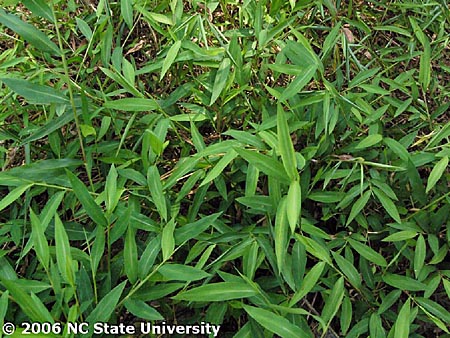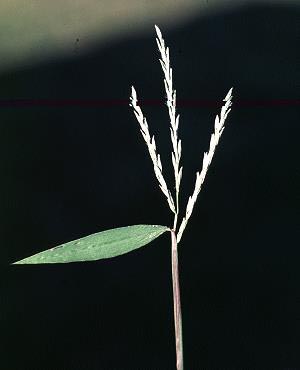We Don’t Have Enough Weeds
So let’s add one more: Japanese Stiltgrass

Japanese stiltgrass (Microstegium vimineum)
About two years ago, I started seeing some different looking grass in my lawn. Perennials, not lawn, are my priority, so I probably wouldn’t have noticed, except this grass was light green and looked like very low growing bamboo. I immediately thought the stand of bamboo I had been working for years to banish from one edge of my property had found its way to the other side. But I soon learned this new invasion was NOT bamboo, but Japanese stiltgrass, a totally new weed to me.
Read on if you want the scoop on Japanese stiltgrass; the probability is good that you will find this nasty invader in your lawn or ornamental areas. In fact, Dr. Shawn Askew, top lawn weed expert at Virginia Tech says Japanese stiltgrass has been the number one plant submitted to the Virginia Weed Identification Clinic for the past 8 years. So count yourself lucky if it hasn’t found you yet, but be vigilant.
What, where, when?
Microstegium vimineum (also known by common names of Japanese stiltgrass, Nepalese browntop, Asian stilt grass, bamboograss, eulalia, and more) is an annual summer grass that spreads rapidly, especially into areas where the soil has been disturbed, but it invades undisturbed areas as well. The plentiful seeds it produces are light and able to float, so they are easily spread by water from surface runoff, streams, and floods. The seeds also spread by clinging to animals like those squirrels, deer, and even birds you welcome to your yard. Humans spread the seeds on clothing, shoes, and wheels of tractors and lawnmowers. Soil found in flood plains and stream sides provides ideal habitat, but other typical habitats include damp fields, lawns, moist woodland edges, roadsides, empty lots, utility right of way, and ditches. Stiltgrass thrives in moderate to densely shaded areas, even in deeply shaded forests, but it is also happy in areas of full sun with adequate moisture.
Japanese stiltgrass has a broad range throughout East Asia. It is native to Japan, Korea, Nepal, China, Malaysia and India. It is believed to have been introduced early in the 1900’s from grasses used as cheap and lightweight packaging material in the shipment of fragile items like porcelain and fine China. And after accidentally finding its way to a place in the U.S. where it could happily reproduce, it has been spreading at a steady rate for nearly a century.
In 1919 Tennessee was the first state to identify and report stiltgrass. It was found in western North Carolina in 1933, and by 1972 stiltgrass was known to be in 14 eastern states (including all states bordering VA, and extending north to Connecticut and Massachusetts, south to Florida, and as far west as Arkansas and Texas. Identified in Virginia in 1931, by 1997 this invader had made its way into every county in the Commonwealth.
Stiltgrass now threatens native understory vegetation in our national parks, conservation areas, wetlands, and roadsides. It is the number one invasive weed problem in the Smokey Mountain National Park. It is considered a serious environmental threat to native plant species. In unmanaged areas it easily replaces other vegetation by shading it out. It has very little — if any — wildlife food value. Foraging animals — even deer and goats – avoid it, preferring our native plants, thus further reducing native vegetation and habitat.
If you have not dealt with stiltgrass, you are either lucky, or you employ excellent lawn and garden cultural practices.
Identification of stiltgrass
Stiltgrass can reach a height of over 3 feet with lance shaped leaves 4 to 5 inches long and half an inch wide alternately arranged on the stalk. The leaves have a silver stripe down the middle, and they are fringed with tiny hairs.
 Described as lime or light green in color, stiltgrass leaves fade to pale greenish yellow or turn a pale purple brown in late fall; winter thatch is bright tan to orange.
Described as lime or light green in color, stiltgrass leaves fade to pale greenish yellow or turn a pale purple brown in late fall; winter thatch is bright tan to orange.
Stiltgrass can be confused with cutgrass, also known as whitegrass (Leersia virginica), a native grass which is thinner and has longer leaves (6 inches). Smartweed also known as knotweed (Polygonum persicaria), is another look-alike, but it is more easily distinguished from stiltgrass. Knot weed is not grass-like, and its pale to dark pink flowers are more noticeable. Its roots are more fibrous and harder to pull than stiltgrass.
Stiltgrass seeds begin germinating in early spring when soil temperatures have been in the 55-60 degree range for about a week. In our area this typically occurs anytime from March through mid-April. Seeds will continue to germinate throughout the summer. It produces inconspicuous flowers by early August, with seed production beginning two weeks later and continuing through September and October. A high percentage of seeds remains viable in the soil for 3 to 5 years, possibly up to 7.
Control without herbicides

Stiltgrass seedheads
Mulching in your garden beds is a good way to keep most weed seeds from germinating. In lawns the best way to prevent or minimize weeds is having a healthy, dense lawn.
If you find stiltgrass has invaded, hand pulling or hoeing is very effective at preventing this shallow rooted grass from spreading and colonizing. Early control of stiltgrass is important, as it quickly spreads by rooting from stem nodes that touch the ground. If allowed to seed, each plant can produce from 100 to 1,000 seeds. Plants are best pulled in August to prevent seed maturation and dispersal. However, the soil disturbed by pulling or hoeing can bring to the surface seeds from previous seasons, and these stiltgrass seeds may have time to germinate.
Tips to control stiltgrass in your lawn
Stiltgrass is a summer annual weed that dies at the first frost but leaves behind many seeds to grow next year’s plants. For small clumps hand-pull these shallow-rooted weeds during summer. If that is impractical, the same pre-emergent chemicals that control crabgrass also control stiltgrass. If you are using a pre-emergent in the spring to control crabgrass, put it down two weeks earlier, and you will control stiltgrass as well.
Cut the weeds at or slightly below the soil surface when hoeing to minimize soil disturbance. Deep hoeing exposes more weed seeds. Mowing or weed whacking of larger infestations should also be done in late summer. You will want to bag and discard in the trash any plants you remove that might have seeds – do not add to compost or lawn recycling bins.
You should also be aware that burning is not an effective control measure. There are also indications that plants cut early in the season respond by regrowing quickly and flowering much earlier than they would normally. And routine mowing, as in a lawn area, causes stiltgrass to set seeds at a low height. Very low mowing on a regular basis and bagging the clippings may help keep that seed from your lawn, but this is problematic as you would be damaging your desirable lawn grass by mowing at that lower height.
Control using herbicides
Always check herbicide labels to determine whether the product will work against the weed you want to treat and whether the product is safe for ornamentals and wildlife in the areas you plan to treat. When using any herbicide, it is important to read the label carefully before you buy and again before using to ensure you understand and can adhere to the application requirements and the necessary safety precautions.
There are two broad categories of herbicides: pre-emergent and post-emergent. Pre-emergent herbicides are used to prevent seeds from germinating. For annual summer weeds like stiltgrass, application is in early to mid-Spring.
Post-emergent herbicides are applied when the weeds are actively growing. Post-emergent herbicides can be either selective or non-selective. Selective means the herbicide will kill or damage the target weed without seriously harming other plants (examples are listed on the label). Non-selective means the herbicide kills or injures all plants it contacts. Non-selective herbicides also affect some woody plants.
Glyphosate (Roundup and other trade names) is a nonselective systemic herbicide; it will destroy or affect all green vegetation. Glyphosate is effective against Japanese stiltgrass, but its use in a natural area can also affect desirable species, including your ornamentals and desired lawn grass, or native plants needed by animals and insects for food or shelter.
Herbicides in ornamental beds
Some pre-emergent chemistries useful against stiltgrass in ornamental beds are prodiamine (sold as Barricade), pendimethalin (sold as Pendulum), and oryzalin (sold as Surflan). Check the 2016 Virginia Home Grounds and Animals Pest Management Guide to make sure the pre-emergent chemistry is safe for use with the specific ornamentals where you plan to treat.
If you prefer to spot-treat rather than hand-pull stiltgrass in your ornamental beds, use a post-emergent herbicide applied before it flowers and sets seed (usually August in Northern Virginia). Some products to look for are: sethoxydim (sold as Bonide Grass Beater Over the Top Grass Killer, Segment), fluazifop-p-butyl (sold as Ortho Grass B Gone Garden Grass Killer, and Ornamec Over the Top Grass Herbicide), and fenoxaprop (sold as Acclaim), and glufosinate (sold as Finale). When used according to the label, these herbicides will not damage most non-grass ornamental plants.
Herbicides in lawns
For pre-emergent control, early spring application of an herbicide labeled for crabgrass control will also prevent seed germination of stiltgrass. For maximum effect against stiltgrass, apply the product a little earlier than the date recommended for crabgrass, and re-apply every two months throughout the summer growth period. There are numerous consumer products authorized for use on Virginia lawns for crabgrass control. They typically contain dithiopyr, pendimethalin, triflurilan, or prodiamine.
If your lawn has turned into an expanse of stiltgrass that makes your back ache when you think about hand-pulling, a post emergent herbicide can be applied before seed set. Look for products containing fenoxaprop (sold as Acclaim and approved for use by Virginia homeowners). A mixture of topramezone (sold as Pylex) and triclopyr (sold as Turflon Ester) is an effective post-emergent treatment for stiltgrass. However, topramezone is not packaged in quantities (nor is it priced) for homeowner use. If you are interested in this treatment, contact a professional lawn service.
In short, control of Japanese stiltgrass (Microstegium vimineum) – once it finds you – will require your attention for quite some time, perhaps 4 years because the seed is viable in the soil that long. Quick response in applying appropriate controls is vital to minimize its spread. Continued good cultural practice in your lawn and landscaped areas is a good defense. Combine that with appropriate annual pre-emergent treatments to discourage seed germination, and annual removal of growing plants (by mechanical or chemical methods) to prevent dispersal of new seeds. The solutions may not be perfect, but they are workable.
References to trade names are not an endorsement by the Fairfax County Master Gardeners or the Virginia Cooperative Extension.
References
Discussions with Dr. Shawn Askew, Extension Specialist and Associate Professor, Virginia Tech University
Southeast Exotic Pest Plant Council Invasive Plant Manual, Southeast Exotic Pest Plant Council
Japanese Stiltgrass, Plant Conservation Alliance, Alien Plant Working Group
Invasive Alien Plant Species of Virginia, Virginia Department of Conservation and Recreation
Japanese Stiltgrass, National Park Service, U.S. Fish and Wildlife Service
Invasive Exotic Plants of North Carolina, Cherri Smith, N.C. Department of Transportation
Field Guide to the Identification of Japanese Stiltgrass, Alabama Cooperative Extension System
Lawn Weed Identification, University of Maryland
Japanese Stiltgrass, United States Department of Agriculture
Japanese Stiltgrass Control in the Home Lawn and Landscape, Fact Sheet FS12376, Rutgers State University New Jersey Agricultural Experiment Station
Japanese Stilt Grass, Pennsylvania Department of Conservation and Natural Resources
Identifying Japanese Stiltgrass, YouTube, New England Wild Flower Society